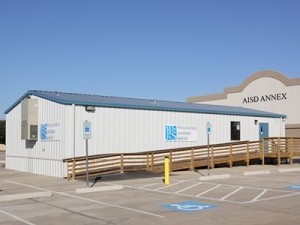 The always changing healthcare market constantly creates ramifications to the access to quality medical care. Lack of insurance for many families compounds the problem especially if they are not eligible for government assistance programs. For this reason many school districts have stepped in to provide healthcare services at freestanding clinics located on existing school campuses. The flexibility of modular buildings that can be quickly designed, manufactured, and installed give a school district the flexibility to establish a presence in one area and relocate the building if their needs or circumstances change.
The always changing healthcare market constantly creates ramifications to the access to quality medical care. Lack of insurance for many families compounds the problem especially if they are not eligible for government assistance programs. For this reason many school districts have stepped in to provide healthcare services at freestanding clinics located on existing school campuses. The flexibility of modular buildings that can be quickly designed, manufactured, and installed give a school district the flexibility to establish a presence in one area and relocate the building if their needs or circumstances change.
A number of independent school districts in Texas are adopting this approach, as our school systems around the country like this one in Hillsboro, Oregon.
The use of modular construction for medical clinics has a long history in the modular building industry. At Ramtech, we’ve been perfecting the process for over 30 years. From our standard floor plan one, two, and four-practitioner models to a host of custom designed facilities, we’ve installed hundreds of clinics throughout the Southwest ranging in size from 1,500 to 10,000 square feet. These include at hospitals like Cook Children’s Medical Center and now at school districts such as Arlington ISD, located here in the Dallas-Fort Worth Metroplex.
For the AISD, the sixth largest school district in Texas serving over 65,000 students at 73 campuses, providing basic medical services and family counseling to their students became critical in helping meet the needs of the community. The AISD, in a partnership with John Peter Smith Hospital of Fort Worth, opened two 1,536 square foot modular medical clinics on property adjacent to two of their existing schools. The primary purpose was to maximize the time in the classroom and minimize the time that many students needed to see an outside physician.
This also provided more flexibility in the hours of operation over clinics that reside inside an existing school building, while also allowing them to operate the facilities without the added restrictions of school security, maintenance, and administrative personnel required for the main campus. The clinics feature an ample sized waiting room, business office with records storage area, exam rooms, procedure room, lab, two nurse’s stations and a physician’s office.
In most cases these clinics qualify under a designation known as a Federally Qualified Health Center and are eligible for federal and state grants for the funding of the building acquisition. The school district then provides the utilities while the healthcare provider, county health department, or a private third party takes care of the medical equipment, supplies, and staffing requirements including the physician or a nurse practitioner.
John Peter Smith Hospital has also partnered with Castleberry ISD, another Fort Worth area school district on a 2,136 square foot clinic that used a slightly larger design at one of their elementary schools. These arrangements can also take the form of a community healthcare clinic, providing services to not only students but eligible residents of the local community at large. This was the case with Goose Creek CISD in South Texas which has a custom clinic located at one of their schools operating in a partnership with the Harris County Health Department. A similar arrangement has also been proposed for the Cross County School District in Arkansas through a partnership with regional healthcare provider ARCare.
